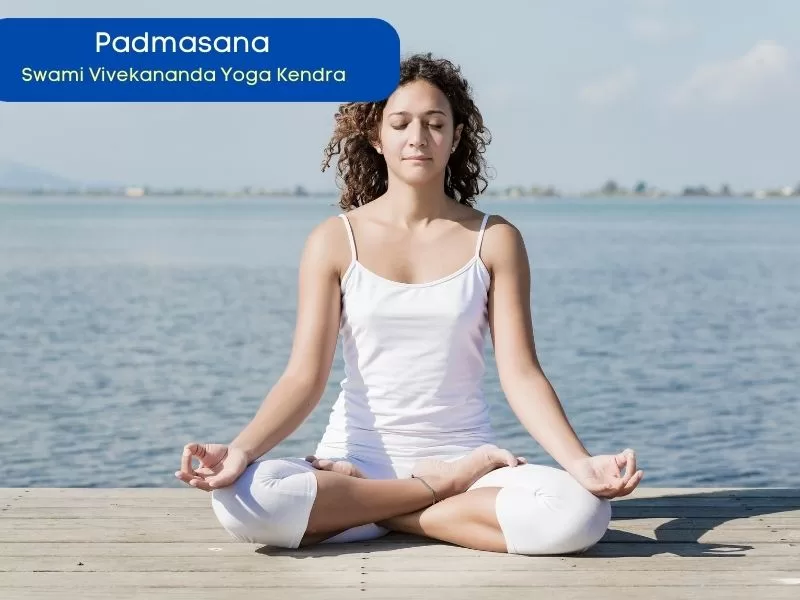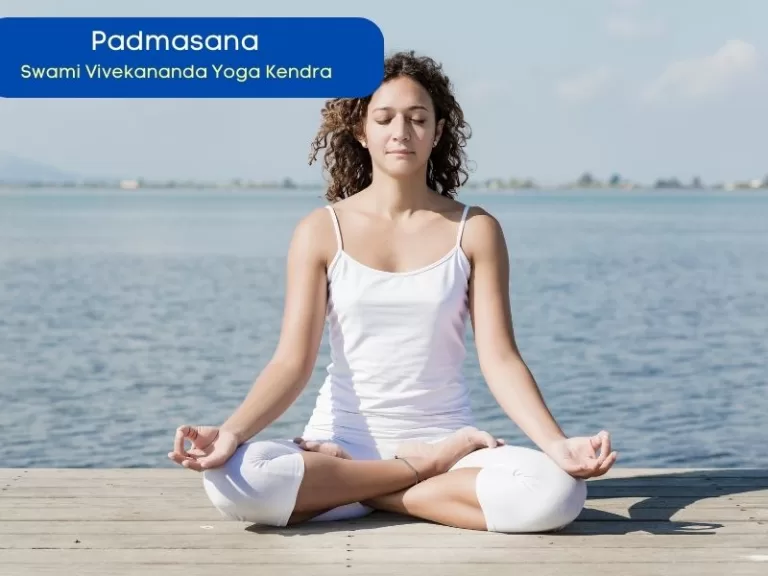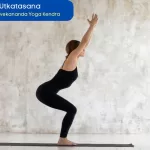Today, we’re going to explore the peaceful and calming practice of Padmasana, which is also called the Lotus Pose. Let’s take a closer look at how to do it, why it’s beneficial, and what makes it such an iconic yoga posture.
Understanding Padmasana:

Let’s talk about Padmasana, also known as the Lotus Pose. This seated yoga posture is a timeless favorite, cherished for its calming and centering effects. When you practice Padmasana, it’s like emulating the gentle elegance of a lotus flower, which symbolizes purity and spiritual growth.
Steps to Perform Padmasana:
Find Your Seat: Sit comfortably on the floor with your legs extended and your back straight.
Bend Your Right Knee: Bring your right foot up and place it on your left thigh, drawing your heel close to your abdomen.
Bend Your Left Knee: Similarly, bring your left foot up and place it on your right thigh, ensuring both knees are resting on the ground.
Adjust Your Position: Make sure your spine is straight, shoulders relaxed, and hands resting on your knees or in a mudra position.
Lengthen Your Spine: Imagine a gentle tug pulling you up from the top of your head, elongating your spine and lifting your chest.
Close Your Eyes: Soften your facial muscles, gently close your eyes, and turn your attention inward.
Breathe Mindfully: Take slow, deep breaths, allowing your body to relax with each inhale and your mind to find calmness with each exhale.
Benefits of Padmasana:
Promotes Physical Stability: Padmasana isn’t just about sitting prettily; it also strengthens your back muscles and improves posture, making you more stable and balanced.
Enhances Concentration: When you practice Padmasana, you naturally turn your focus inward. This inward focus enhances concentration, making it an ideal pose for meditation and mindfulness.
Stimulates Energy Flow: Padmasana helps to get your energy flowing smoothly throughout your body, leaving you feeling more vibrant and revitalized.
Aids Digestion: By gently compressing the abdomen, Padmasana stimulates digestion, helping to alleviate digestive issues and promote a healthy gut.
Calms the Mind: Padmasana is like a soothing balm for your mind, helping to melt away stress and anxiety. It’s your go-to pose for finding inner peace and tranquility, especially after a busy day.
Increases Flexibility: With regular practice, Padmasana gently opens up your hips and knees, making it easier for you to sit comfortably for longer periods. It’s like giving your body a gentle stretch, helping you feel more limber and relaxed.
Improves Blood Circulation: When you settle into Padmasana, you’re giving your body a gentle massage from the inside out. This pose encourages healthy blood flow, ensuring that your cells receive all the oxygen and nutrients they need to thrive, while also flushing out any toxins.
Elevates Mood: Strike a pose and boost your mood! Padmasana triggers the release of those feel-good hormones, endorphins, leaving you with a sense of happiness and well-being. It’s a natural mood lifter that helps you feel more positive and uplifted.
Is Padmasana suitable for beginners?
Absolutely! While Padmasana may seem challenging at first, with practice and patience, beginners can gradually ease into this pose. Start by sitting cross-legged and gradually work towards bringing one foot up onto the opposite thigh.
How long should I hold Padmasana?
The duration of holding Padmasana can vary depending on your comfort level and practice. Beginners may start with a few breaths and gradually increase the duration as they become more accustomed to the pose. Aim for at least 30 seconds to a minute initially.
Can Padmasana help with anxiety and stress?
Yes, Padmasana is known for its calming and grounding effects on the mind. By promoting relaxation and deep breathing, this pose can help alleviate feelings of anxiety and stress. Incorporating Padmasana into your daily routine can be a soothing way to find inner peace.
I have knee or hip issues. Can I still practice Padmasana?
If you have knee or hip issues, it's essential to approach Padmasana with caution. You can modify the pose by using props like cushions or blankets to support your knees and hips. Listen to your body and avoid forcing yourself into the pose. Consulting with a yoga instructor or healthcare professional can also provide personalized guidance.
Can I practice Padmasana during pregnancy?
While Padmasana can be beneficial for pregnant women in the early stages of pregnancy, it's essential to approach it with care and avoid excessive pressure on the abdomen. As pregnancy progresses, it may become uncomfortable or challenging to practice Padmasana due to changes in the body. It's best to consult with a prenatal yoga instructor or healthcare provider for suitable modifications and alternatives.
Step into the serene world of Padmasana, also known as the Lotus Pose. It’s not just a yoga posture; it’s your ticket to a calmer, more balanced life. By making Padmasana a part of your practice, you’re not just sitting pretty – you’re opening the door to a whole new level of well-being. Picture this: as you settle into Padmasana, you’re not just crossing your legs; you’re crossing into a realm of deep relaxation and tranquility. With each breath, you’re not just stretching your body; you’re stretching your mind, finding a sense of peace and harmony within. It’s like taking a journey inward, exploring the depths of your being and discovering a wellspring of calmness and contentment. So why wait? Join us at Swami Vivekananda Yoga Kendra and let Padmasana guide you on a path to inner peace and self-discovery.
Transform Your Life with us: Join Our Online Classes Now:
Ready to dive into a world of wellness? Come join us for some online meditation classes to find your inner calm, hop into our online yoga classes to take your practice up a notch, or why not even become a certified yoga teacher? Embrace the power of yoga today and let it lead you to a happier, healthier you!




Comments are closed.